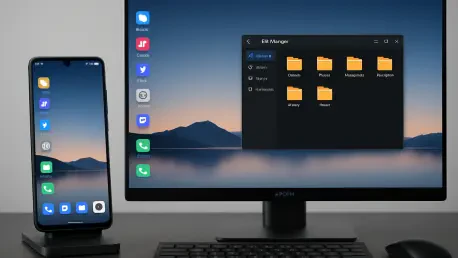In an era where the boundaries between mobile devices and traditional computing are increasingly blurred, a remarkable update to Google Chrome on Android has emerged as a game-changer for Xiaomi smartphone users, promising to redefine versatility. Imagine plugging a phone into an external monitor and instantly accessing a full desktop browsing experience, without the hassle of manually adjusting settings for each website. This innovative development promises to turn Xiaomi devices, such as the latest flagship models, into powerful pocket-sized PCs, catering to the growing demand for productivity on the go. With mobile technology evolving at a rapid pace, this feature addresses a critical pain point for users who rely on their smartphones for both personal and professional tasks, offering a seamless bridge between mobile convenience and desktop functionality. This advancement not only enhances user experience but also signals a broader shift in how smartphones are perceived as viable alternatives to traditional computers.
Bridging the Mobile-Desktop Gap
Enhancing Browsing with Desktop Mode
A significant frustration for Android users, including those with Xiaomi devices, has long been the limited experience when connecting smartphones to larger screens. Typically, websites detect the device as mobile and render simplified layouts that feel cramped and restrictive on external monitors. The new Chrome feature, currently in experimental testing, introduces a solution through an innovative flag known as “Request Desktop User-Agent on External Displays.” When activated, this setting automatically signals websites to load their full desktop versions whenever a device operates in Desktop Mode on a connected screen. The result is a browsing experience that mirrors a traditional PC, complete with comprehensive layouts, side navigation bars, and enhanced functionality on platforms like YouTube or Reddit. This eliminates the tedious need to manually request desktop versions for each tab, ensuring a smoother and more intuitive interaction with web content on larger displays for Xiaomi users seeking efficiency.
Boosting Productivity on the Go
Beyond just improving web layouts, this Chrome update holds transformative potential for productivity. Xiaomi smartphones, when paired with an external monitor, can now serve as multitasking hubs, allowing users to handle complex tasks that were once reserved for laptops or desktops. Whether drafting detailed documents, managing spreadsheets, or engaging in video conferences, the desktop-like interface fosters an environment conducive to serious work. This development aligns with the evolving capabilities of Android’s Desktop Mode, which continues to refine how mobile devices integrate with larger ecosystems. For professionals and students alike, the ability to transition seamlessly from a handheld device to a full workstation offers unparalleled flexibility. As smartphones become more powerful, features like this empower Xiaomi users to rely less on bulky hardware, redefining what it means to work efficiently while traveling or in compact spaces without sacrificing functionality.
Future Implications for Mobile Computing
Redefining Smartphone Utility
Looking ahead, the implications of this Chrome feature extend far beyond mere convenience for Xiaomi users. It represents a pivotal step in the ongoing trend of smartphones evolving into legitimate substitutes for traditional PCs in specific contexts. With hardware capabilities advancing rapidly, devices like the Xiaomi 15 or Xiaomi Pad 6 are already equipped with processing power rivaling many entry-level computers. Coupling this with software innovations that prioritize desktop-grade experiences on external displays, the line between mobile and stationary computing continues to blur. This shift caters to a growing demographic of users who value portability without compromising on performance. As more applications and services adapt to such hybrid functionalities, the reliance on dedicated desktop setups could diminish, positioning smartphones as all-in-one solutions for both casual and professional needs in an increasingly mobile-centric world.
Supporting Ecosystem Enhancements
Another layer of this development lies in how it integrates with the broader Xiaomi ecosystem, amplifying the impact of this Chrome update. Tools and platforms designed to keep systems optimized and unlock hidden features further enhance the user experience, ensuring devices remain at the cutting edge of functionality. For instance, staying updated with the latest software patches or accessing experimental settings can maximize the benefits of Desktop Mode compatibility. This synergy between hardware, software updates, and supplementary resources creates a robust environment where Xiaomi users can fully exploit their devices’ potential. As Google continues to refine this feature based on user feedback and testing phases, the collaboration with manufacturers like Xiaomi will likely yield even more tailored solutions. Reflecting on the strides made, it’s evident that such advancements lay a strong foundation for reimagining mobile devices as versatile computing tools, addressing real user challenges with practical innovation.
Closing Thoughts: A Step Toward Seamless Integration
Reflecting on the strides achieved with this Chrome update, it becomes clear that Xiaomi users have gained a powerful tool to elevate their devices’ utility. The automatic loading of desktop website versions on external displays tackles a persistent issue, delivering a polished and consistent browsing experience. This breakthrough not only enhances productivity but also positions smartphones as credible alternatives to traditional PCs for certain tasks. Looking forward, the focus should shift to how such features can be further refined and expanded to support a wider array of applications and use cases. Collaboration between software developers and hardware manufacturers will be key to unlocking even greater potential. As the industry moves toward a future of integrated, hybrid computing, staying attuned to user needs and technological advancements will ensure that innovations like these continue to redefine the boundaries of what mobile devices can achieve.









